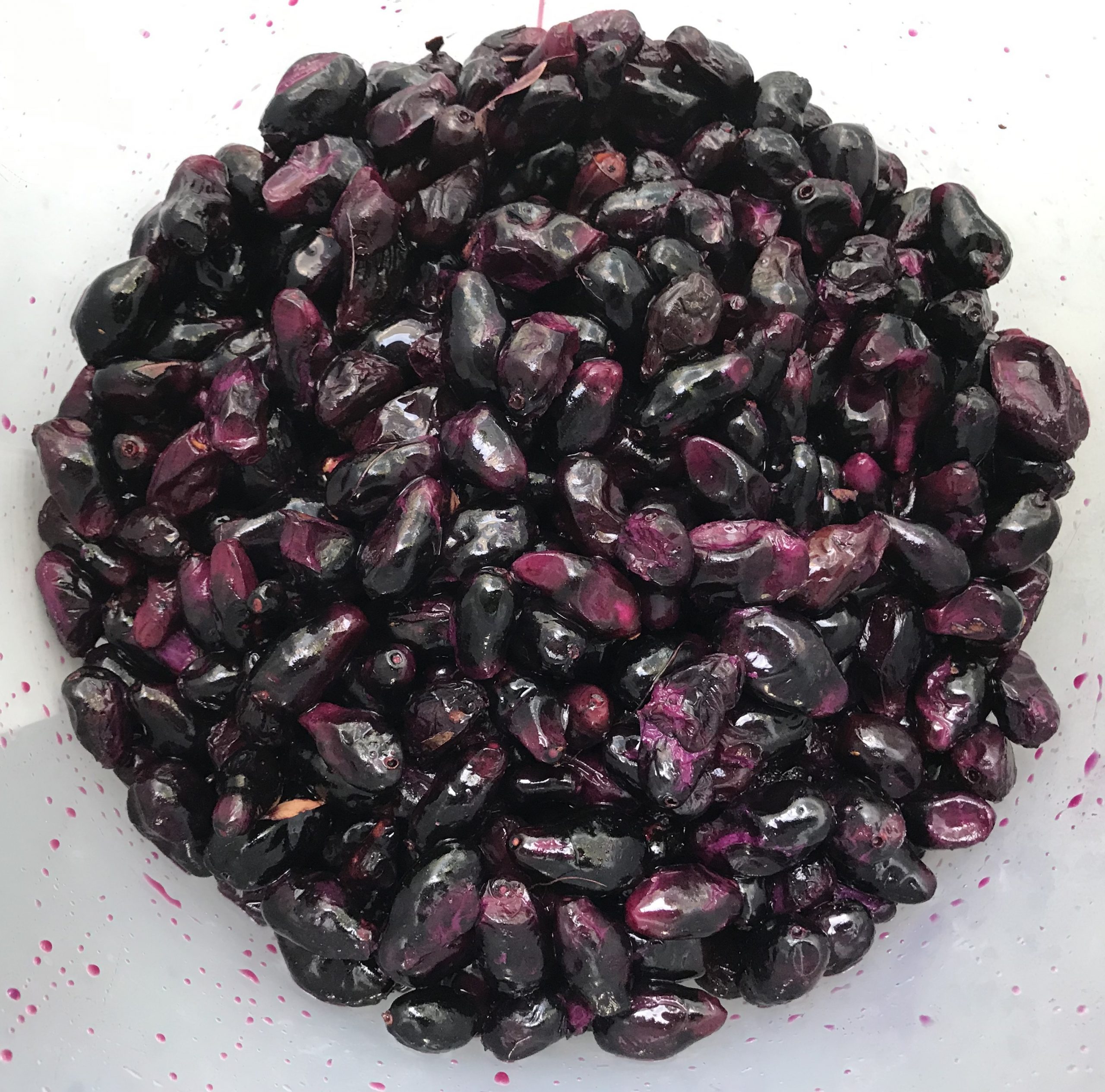
Jambul Fruit being made into wine. Photo by Green Deane
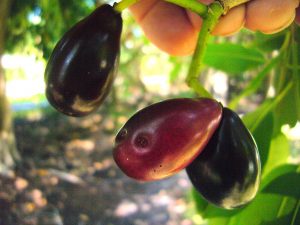
Even ripe Jambul fruit is slightly astringent. Photo by Green Deane
Plants remind one that weather is less dependable than we might think. People who makes plans to live off the land often forget several things among them personal illness, crop predation by bug, animal or fungi, limited hours of daylight to work in, and uncooperative weather (either limiting hours one can work, or, affecting plant production.) We were reminded of the latter this past week with the Java Plum (also called Jambul.) They’re a common tree in south Florida and I know of one and a few relatives in Central Florida. Usually the species fruits in August. That’s a good look- for target month. Last year it was early August if not late July, the year before late August and or September. In West Palm Beach this past weekend some were still blossoming while a couple were dropping unripe, astringent fruit. Usually by now sidewalks near the trees are stained purple with mashed fruit. The trees clearly have a six-week- (or so) window. That’s the effects of weather. Is it because of more or less chill hours? More or less clouds? Is it the amount of rain or timing (and not only for the trees.) Weather can effect pollenating insects. Can they fly when the plant really needs pollinating? Plants are on a very flexible schedule and you have to be, too. You have to do more than know your land: You have to watch, too.
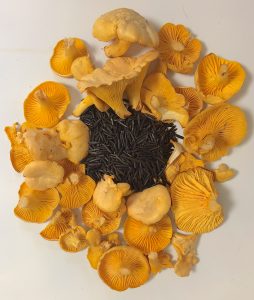
Wild Chanterelles and wild rice waiting to be cooked. Photo by Green Deane
I was asked recently by one of the retired fellows I bike with if the rain was helping my plants. That’s kind of on par with “is sunshine helping your plants?” What he meant but did not say was did the recent rains make a difference. I’m not sure it moved the chlorophylic needle much on green plants but it did stimulate a flush of edible Chanterelles. Several friends and I collected them for several days and did not put a dent in the abundance. (By the way harvesting wild mushrooms is what the mushroom wants just as an an apple tree wants its apples moved.) All mushroom should be stored in paper bags (not plastic) and washed only right before cooking. (I’m certified to sell wild mushrooms in several states, and that is among the instructions.) Interestingly those who study such things now say no mushrooms — wild or cultivated — should be eaten raw. Over a life time, they say, eating raw mushrooms can increase the risk for mitochondria-based cancer. Cook your mushrooms.
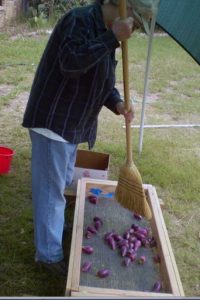
One way to remove glochids from tunas is to sweep them off.
One of the disappointments this time of year is that the Seagrapes are not quite ripe, as we saw in West Palm Beach Sunday. They usually ripen in september, That said the Tuna are running… well… actually ripening: Cactus fruit are called Tuna. We saw plenty of those. There are two or three general types of cactus locally, Opuntia and Nopales and a third with edible fruit, the Cereus, which is more an ornamental Dragon Fruit. How do you pick a Tuna (or cactus pad?) In a word carefully. Most foragers know cactus have edible parts but what does one look for, generally? First make sure it’s a pad, segmented often oval or tear-drop shaped. You do not want anything that looks serpentine. Also no white sap. White sap in plants that resemble cactus can be very deadly even after being dry many years. In one case smoke from burning desiccated Euphorbia branches killed some stranded people. They were trying to stay warm around the fire on a cold desert night. So, pads, no white sap.
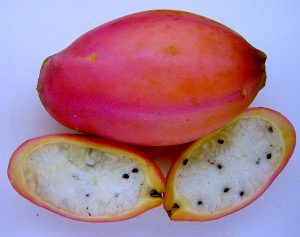
Cereus fruit is soft and semi-sweet. Photo by Green Deane
While which cactus you collect (Opuntia, Nopales, or Cereus) might be the luck of the draw, the less spines the better, and the less glochids the much better. Glochids are tiny tuffs of sharp hair that hurt, are hard to dig out, and last for days. Ma Natures knows the pads and Tuna are good food so she protects them mightily. Big spines can be cut, burned or scraped off, glochids burned or washed off. Just scraping is not so successful with glochids. Wear stiff gloves without seams. Those little glochids will pass right through seams and get ya. Hint: Young pads, the ones we want anyway, often have not developed glochids. The Tuna have them so pick with tongs and sweep, wash or burn the painful parts off. Let us presume you have a spineless, glochidless young pad or tuna. What do you do with it? You can eat it raw, skin and all, or roast it or boil it. I know one restuarant that steams pads (preserving color) then lightly grills them inserting them whole on Mexican-esque hamburgers. With older (de-spined) pads you can still eat them raw or cook. Usually the tougher spine “eyes” are removed just like you would with a potato. And the pad can be peeled as well. Pads at a certain point become woody and too tough to eat. The tunas can have a raspberry flavor. The seeds are edible, too, but are extremely tough. You have to grind or roast them The pink foot-ball shaped fruit of the Cereus are spineless and totally edible, skin soft seeds and white pulp usually raw. To read more about cactus click here.
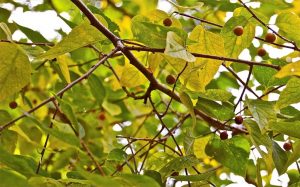
Sugarberries/Hackberries are starting to ripen.
There is a tree you should be scouting for now so when the fruit ripens next month you’ll have some already located. As in real estate so in foraging: Location, location, location. Hackberries (also widely know as Sugarberries) like to be near but not in fresh water. You can often find them about 10 feet above the local water table but I’ve seen them as low as three feet. Usually you can find them up the bank from the water. Older Hackberry bark will often be warty, sometimes heavily so. Leaves have uneven shoulders, and on the back side of the leaf notice three prominent veins at the base, unusual for tree leaves. The small-pea sized fruit is green now but will ripen this month or early September into a burnt orange. The entire fruit is edible though the seed is hard. To read more about them go here.
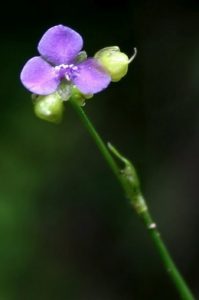
Doveweed
Doveweed, Murdannia, might be the smallest non-floating edible plant in the United States. Barely known, easily overlooked, yet very invasive. It pays to be small. For some young Doveweed is prime for soups, others view it as famine food. I can understand that. It’s closely related to a genus that gives me an upset stomach, the Commelinas (Dayflowers.) I use only Doveweed blossoms in my salad. To anyone used to finding Dayflowers the Doveweed will look familiar but only a few inches tall. It also has a lot of common names around the world including “Micky Mouse.” To read more about the Doveweed, go here.

Classes are held rain or shine or cold. (Hurricanes are an exception.) Photo by Kelly Fagan.
Foraging Classes this week depend upon the weather, which is always a challenge this time of year. If the tropical storm that is bewing – Fred — slows or weakens a little and there is just rain in southwest Florida the Port Charlotte class will go on. If it is blowing a gale, no. Same with Banchard Park on Sunday, which has a greater possibility of happening. I hold classes in the rain regularly. It is rain and wind that gets in the way. We’ll just have to watch the weather. You can also email me at GreenDeane@gmail.con.
Saturday August 14th, Bayshore Live Oak Park, Bayshore Drive. Port Charlotte. 9 a.m. to noon. Meet at the parking lot in the park on Bayshore at Ganyard Street.
Sunday August 15th, Blanchard Park, 10501 Jay Blanchard Trail, Orlando, FL 32817. 9 a.m. till noon. Meet at the pavilion next to the tennis courts.
Saturday August 21st, Eagle Park Lake, 1800 Keene Road, Largo, FL 33771. 9 a.m. to noon. Meet at the pavilion near the dog park.
For more information, to pre-pay or sign go here.
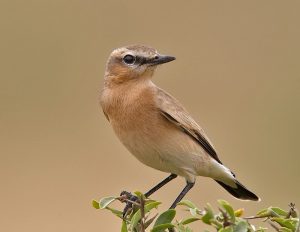
The Isabelline Wheateater
To my knowledge I’ve never met anyone named Isabell. So when the word “isabelline” crossed my optical path I had to look into it. “Isabell” means “God’s promise” presumably a positive one. It was very popular girl’s name in the 1880s, all but disappear until 2003 whereupon it had a resurgence in popularity until 2007. Now it is on the wane again. But what is isabelline? There are three application: One is what we could call Spanish Gothic Architecture. King and queen Ferdinand and Isabella got Columbus launched then turned to building cathedrals and the like. That style is called Isabelline, properly capitalized. I’m surprised they didn’t called it Ferdinine. The second use is a color: Isabelline. A color? Yes, and the word has been in use for at least 400 years so it is not a paint-store invention like “Baby Fawn.”
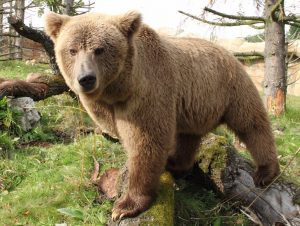
A Himalayan Brown Bear (Ursus arctos isabellinus.)
Isabelline “means a light yellow-gray and used mostly to describe mushrooms, animals and birds. There is the Isabelline Wheateater, see above left, the Isabelline Shrike, and the Isabelline Bear, right. Horses that are a cross between a Golden Palomino and a Champagne Palomino are also called Isabelline. Now, what of the third use? Well… ahem….Isabelline is also a reference to faded underwear. The story comes from when Philip II of Spain laid siege to the city of Ostend in 1601. His daughter, Isabella, Archduchess of Austria, made a rather presumptuous vow not to change her underwear until the city was taken, thinking dad would be home by supper, lunch by Sunday for sure… Unfortunately for Isabell — and those around her — the siege took three years. Thus the color of dingy underwear is called “isabelline.”

Green Deane videos are now available on a USB.
My nine-DVD set of 135 videos has been phased out and replaced by a 150-video USB. The USB videos are the same videos I have on You Tube. Some people like to have their own copy. The USB videos have to be copied to your computer to play. If you want to order the USB go to the DVD/USB order button on the top right of this page or click here. That will take you to an order form. I’d like to thank all of you who ordered the DVD set over the years which required me to burn over 5,000 DVDs individually.

Green Deane Forum
Want to identify a plant? Perhaps you’re looking for a foraging reference? You might have a UFO, an Unidentified Flowering Object, you want identified. On the Green Deane Forum we — including Green Deane and others from around the world — chat about foraging all year. And it’s not just about warm-weather plants or just North American flora. Many nations share common weeds so there’s a lot to talk. There’s also more than weeds. The reference section has information for foraging around the world. There are also articles on food preservation, and forgotten skills from making bows to fermenting food.
 Your donations to upgrade the EatTheWeeds website and fund a book were appreciated. A book manuscript has been turned it. It had 425 articles, 1326 plants and a third of a million words. What it will be when the publisher is done with it next year is unknown. It will be published in the spring of 2023. Writing it took a significant chunk of time out of my life from which I have still not recovered. (Many things got put off.) The next phase is to update all the content on the website between now and publication date. Also note as it states above the 135-video DVD set has been phased out for 150-video USB. Times and formats change. Which reminds me I need to revisit many plants and make some new videos.
Your donations to upgrade the EatTheWeeds website and fund a book were appreciated. A book manuscript has been turned it. It had 425 articles, 1326 plants and a third of a million words. What it will be when the publisher is done with it next year is unknown. It will be published in the spring of 2023. Writing it took a significant chunk of time out of my life from which I have still not recovered. (Many things got put off.) The next phase is to update all the content on the website between now and publication date. Also note as it states above the 135-video DVD set has been phased out for 150-video USB. Times and formats change. Which reminds me I need to revisit many plants and make some new videos.
This is weekly newsletter #469. If you want to subscribe to this free newsletter you can find the sign-up form in the menu at the top of the page.
To donate to the Green Deane Newsletter click here.

